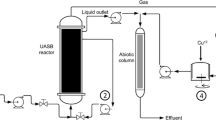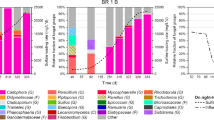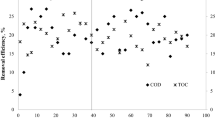Abstract
Ecological relationships between sulfate-reducing and methane-producing bacteria in mud of Lake Vechten have been studied by continuous culture studies using the chemostat technique. The maximum specific growth rate (μ max) and saturation constant (K s) were, respectively, 0.36 hr−1 and 0.047 mM for lactate-limited growth ofDesulfovibrio desulfuricans and 0,011 hr−1 and 0.17 mM for acetate-limited growth ofMethanobacterium sp. Calculated values for the true molar growth yieldsY G) and maintenance coefficients (m) were 30.6 g bacterial mass/mole of lactate and 0.53 g substrate/g dry wt hr forD. desulfuricans and 37.8 g bacterial mass/mole of acetate and 0.54 g substrate/g dry wt hr forMethanobacterium.
No growth ofMethanobacterium was observed at apS2− value (the hydrogen sulfide potential) of more than 11 and there was no effect on the growth atpS2− values above 13. In mixed continuous culture experiments the concentration of acetate decreased in the secondstage growth vessel, whereas that of methane increased stoichiometrically. If the substrate concentration in the reservoirs (S r) was increased from 0.1 to 0.5 mg/ml, the population ofDesulfovibrio increased and that ofMethanobacterium was washed out of the culture vessel, since the concentration of hydrogen sulfide reached apS2− value of 10.5. From the mixed continuous culture experiments a commensalism between the two species can be described, i.e., the acetate-fermentingMethanobacterium benefits from the acetate released byDesulfovibrio which is, in turn, not affected in the presence of the former.
Similar content being viewed by others
References
Baker, K. 1968. Low cost continuous culture apparatus.Lab. Pract. 17: 817–824.
Barker, H.A. 1936. Studies upon the methane-producing bacteria.Arch. Mikrobiol. 7: 420–438.
Cappenberg, Th. E. 1972. Ecological observations on heterotrophic, methane oxidizing and sulfate reducing bacteria in a pond.Hydrobiologia 40: 471–485.
Cappenberg, Th. E. 1974. Interrelations between sulfate-reducing and methane-producing bacteria in bottom deposits of a fresh-water lake. I. Field observations.Antonie van Leeuwenhoek 40: 285–295.
Cappenberg, Th. E. 1974. Interrelations between sulfate-reducing and methane-producing bacteria in bottom deposits of a fresh-water lake. II. Inhibition experiments.Antonie van Leeuwenhoek 40: 297–306.
Cappenberg, Th. E. and Prins, R.A. 1974. Interrelations between sulfate-reducing and methane-producing bacteria in bottom deposits of a fresh-water lake. III. Experiments with14C-labeled subslrates.Antonie van Leeuwenhoek 40: 457–469.
Gemerden van, H. 1967. On the bacterial sulphur cycle of inland waters. Thesis, Leiden.
Hungate, R.E. 1969. A roll tube method for cultivation of strict anaerobes.In: Methods in Microbiology. J.R. Noris and D.W. Ribbons, editors. Vol. 3B, pp. 117–132. Academic Press, New York.
Mylroie, R.L. and Hungate, R.E. 1954. Experiments on the methane bacteria in sludge.Can. J. Microbiol. 1: 55–64.
Pirt, S.J. 1965. The maintenance energy of bacteria in growing cultures.Proc. Royal Soc. B 163: 224–231.
Postgate, J. 1965. Enrichment and isolation of sulfate-reducing bacteria.Zbl. Bakt. l. Abtl., Supplementheft 1: 190–197.
Postgate, J. and Campbell, L.L. 1966. Classification ofDesulfovibrio species, the nonsporulating sulphate-reducing bacteria.Bact. Rev. 30: 732–738.
Pretorius, W.A. 1972. The effect of formate on the growth of acetate utilizing methanogenic bacteria.Water Res. 6: 1213–1217.
Senez, J.C. 1962. Some considerations on the energetics of bacterial growth.Bact. Rev. 26: 95–107.
Stouthamer, A.M. 1973. A theoretical study on the amount of ATP required for synthesis of microbial cell material.Antonie van Leeuwenhoek 39: 545–565.
Stouthamer, A.H. and Bettenhaussen, C. 1973. Utilization of energy for growth and maintenance in continuous and batch cultures of microorganisms. A reevaluation of the method for the determination of ATP production by measuring molar growth yields.Biochim. Biophys. Acta 301: 53–70.
Tempest, D.W. 1970. The cultivation of micro-organisms. I. Theory of the chemostat.In: Methods in Microbiology. J.R. Noris and D.W. Ribbons, editors. Vol. 2, pp. 259–276. Academic Press, New York.
Veldkamp, H. and Jannasch, H.W. 1972. Mixed culture studies with the chemostat.J. Appl. Chem. Biotechnol. 22: 105–123.
Wolfe, R.S. 1971. Microbial formation of methane.Advan. Microbial Physiol. 6: 107–146.
Zeikus, J.G. and Wolfe, R.S. 1972.Methanobacterium thermoautotrophicus sp. n., an anaerobic, autotrophic, extreme thermophile.J. Bacteriol. 109: 707–713.
Author information
Authors and Affiliations
Rights and permissions
About this article
Cite this article
Cappenberg, T.E. A study of mixed continuous cultures of sulfate-reducing and methane-producing bacteria. Microb Ecol 2, 60–72 (1975). https://doi.org/10.1007/BF02010381
Issue Date:
DOI: https://doi.org/10.1007/BF02010381




